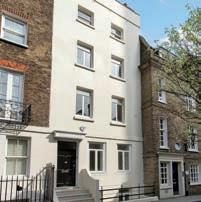
6 minute read
TRANSPARENCY BEGETS TRUST
highest. These adjustments are so slight that, month-to-month, they are largely imperceptible, especially with regard to a typically unique country house. This inelasticity of prices is illustrated by one Exeter sale also just agreed at the time of writing, in which four would-be buyers of a £600,000 house submitted their best and final offers. All four were within £5,000 of each other. When the spread between competing bids is less than 1%, the message is clear: buyers know what properties are worth and they will not overpay.
TIME-RICH BABY BOOMER BUYERS
Who are these well-informed, poker-faced buyers?
The comment from Simon Milledge of our Blandford Forum office – which, after a slow spring, has had a tremendously busy summer – rings true for many others:
“Demand is highest for good family houses, but we rarely sell them to families. Most buyers are empty nesters and baby boomers. They are serious about moving, but the classic time pressures just aren’t there.”
This is a key point. Today’s older buyers are not changing jobs or expecting a baby, so they have no deadline. Coupled with healthy but relatively fixed levels of income and equity, their incentive and ability to go above a genuine maximum, is tightly restricted. They also ask a lot more questions about maintenance costs and neighbours.
South East Market Share Growth
Even in the South East, the main issue has not been a shortage of buyers or stock, but the length of time taken for sales to go through (having a knock-on effect where sellers are buying in a different region).
There are numerous reasons behind this, but one positive effect for us has been a shift by sellers towards agents (and solicitors) whom they know will be highly proactive in both negotiating a deal and then nurturing it through to completion. This has enabled our south eastern offices to gain market share and thus maintain volumes even within slower markets. For the new Mid Sussex office, it has enabled them to go from zero-to-profitable in just a few months. To quote director Toby Whittome: “A tougher market is great for us because sellers abandon old relationships in favour of someone more effective. Personally, I never think one buyer is enough. You need at least two – then the whole dynamic changes and we get a chance to secure what really is, the best price.”
Above: Norfolk £1,250,000 guide (Norwich)
Bottom left: Newmarket £895,000 guide (Newmarket)

In any negotiation, though it’s natural to want to play your cards close to your chest, it is not always in your best interests.
In many regional markets, much current demand for country houses to rent is from tenants hoping to buy within a year (an existing trend fuelled, a little counter-intuitively, by a slower sales market in the South East). The problem is that it could be anything from four to twenty-four months before the tenant no longer needs the house, so no one can know when, and on whom, additional costs and stresses will arise. Worse if, as so often, it is assumed that the ideal rental term for the landlord is one cast in stone, whilst that for the tenant is ‘just as long as we need’, both sides start from a guarded position.
In practice, the situation is almost always more nuanced. What the landlord really wants is a responsible tenant and security of income, whilst the tenant simply wants a relatively modest degree of flexibility. Both sides often have other factors to consider, too, such as major maintenance works and school holidays. By revealing these and looking to accommodate each other’s requirements, simple arrangements such as tailored minimum notice periods, or taking income from re-letting into account and, most of all, frequent communication, can work wonders in facilitating agreement.
Impact Of Tenant Fee Ban
Lack of transparency and trust played a big part, too, in the saga of tenant fees and their banning from 1st June 2019. For us, the impact has been positive, because our offices either didn’t charge fees, or did so without using them as a source of income. Problems arose because of hidden profiteering. Faced with a more transparent market, tenants now approach it with greater confidence, which is good for all. Meanwhile, Jackson-Stops lettings teams whose rivals were relying on tenant fees for a big part of their income (Northampton appears to be a hot spot for this) are enjoying an influx of new business from landlords whose previous agents are trying to charge them more.
Modest Rent Rises
As reported in earlier editions, with landlords facing extra costs, many industry professionals – including the RICS – had predicted that rents would rise sharply as a result. We questioned this and, indeed, have since seen rents rise essentially in line with inflation. Backing this up, according to the ONS, “Rental prices for the UK, excluding London, increased by 1.5% in the 12 months to June 2019.”
Opposite page:
Top: Kent £3,495 pcm (Cranbrook)
Bottom: Northampton £2,700 pcm (Northampton)
Real wage increases might soon fuel rent increases. This, though, underlines that it is what tenants will pay, not landlord costs, which sets rents. In a market as transparent as this one, the landlords and agents who prosper, are those whom tenants can trust.
What will £500,000 buy in the country?
This page, anticlockwise from the left: North Yorkshire £475,000 guide (York)
Dorset £375,000 guide (Bridport)

South Norfolk £369,950 guide (Bury St Edmunds)

Oxfordshire £399,950 guide (Burford)
West Sussex £500,000 (Midhurst)
This page, clockwise from the right: Devon £485,000 guide (Exeter)
Dorset £435,000 guide (Shaftesbury)



Surrey £400,000 guide (Oxted)


West Sussex £525,000 guide (Chichester)
WHAT WILL £500,000 BUY IN THE COUNTRY?
More than double the current UK average house price of £230,000 (Land Registry), what half a million pounds secures, varies greatly across the country.
London Market Comment
DOLLAR MOVERS IN THE WINGS?
Post 2014/15, the number of foreign investors moving to Britain – most with US$-based wealth – dropped 80%. Are they now returning?
Ask commentators about the cause of London price reductions post-2014 and most will point to tax increases designed by George Osborne to take the heat out of the top end of the London market: stamp duty, a new annual property tax (ATED) and extra taxes for private landlords. These factors coincided, though, with numerous others, including new anti-money laundering laws. Together, these led to a reduction, according to Home Office figures, of over 80% in the number of foreign investors moving to Britain in the year to March 2016. The gushing flow of foreign money pouring in to central London and rippling out as sellers took their gains elsewhere, stopped. Prices – rents and capital values – inevitably fell.
The picture today is very different. Since 2014, the US dollar has risen almost 30% against sterling. Prime London rents are down anything from 5% to 20% and capital values, anything from 10% to 30%. If your money is in dollars, this makes a huge difference: an apartment which would have been, in 2014, $1,900 per week, now equates to around $1,200 per week. Even more spectacular, a house for sale in 2014 at say, $8.5 million, would now cost around $4.8 million. Not quite half price, but close. Unsurprisingly, our dollar-based tenants and buyers are much happier and we have no doubt that this is a factor in rents and capital values increasing. We firmly expect rental demand to grow further. Much less certain is whether dollar-based buyers are now held back by the legislative changes referred to above, or whether they are waiting for a measure of political certainty (a big part of the appeal of London having always been its solid, safe haven status). If they are awaiting greater political certainty then, if and when it is regained, they will look to act swiftly, before prices and exchange rates erode their current advantage.
LETTINGS: A NEW STABILITY
There remains strong demand at the top end of the rental market and at all rent levels. Landlords, far from being discouraged from continuing with their letting investment, have been retaining or even growing their portfolios. The fact is that despite lower returns, there are still few better investments. We are witnessing a stronger market which may well see the year end with a modest jump in central London rents. Across central and more suburban markets, demand is healthy and the number of deals done, for us at least, is greater than last year. Looking ahead, we are watching the student market (which, again, is important in all areas) and at what the impact of growing institutional investment in large scale ‘build to rent’ projects might be.

SALES: STRONG WHERE THE BRITS ARE
Prices in central London are holding firm. In areas favoured by overseas and ‘top 1%’ buyers, this is at





